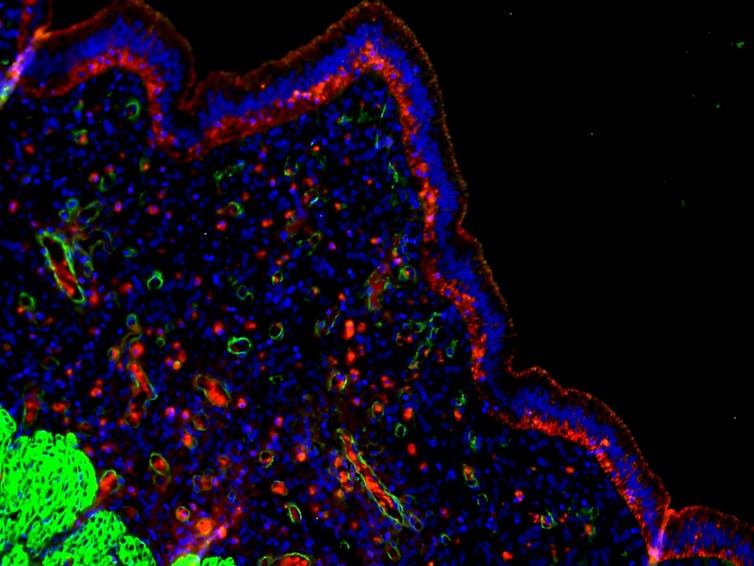Meet the Egyptian spiny mouse: this menstruating rodent may help us understand human pregnancy
- Written by Jarrod McKenna, PhD candidate and academic tutor, Monash University
About 8–12% of couples of reproductive age suffer from infertility, and roughly 15% of all pregnancies end in miscarriage.
The underlying mechanisms of human pregnancy are still poorly understood. In part, this is because pregnancy works quite differently in most mammals.
Read more: Miscarriages affect 1 in 6 pregnancies. We need better investigations and treatments
However, recent research indicates the Egyptian spiny mouse, which menstruates like humans do, could offer an excellent model for research. Our new study, published in Scientific Reports, shows the lining of the mouse’s uterus, or endometrium, also grows in a human-like way to prepare for embryo implantation.
Why animal models are important
There are many reasons for miscarriage and other pregnancy complications, ranging from hormonal and vitamin imbalances to failure of placental development and impaired embryo implantation. To understand these conditions, researchers need to do experiments – but doing experiments on humans poses serious ethical, practical and financial challenges.
That’s why researchers try to “model” the conditions in suitable laboratory animals. Animal models (using rodents in particular) have helped explain many aspects of human reproduction, but they are limited by fundamental differences between human reproduction and that of other species.
Read more: We mightn't like it, but there are ethical reasons to use animals in medical research
Less than 2% of all mammal species menstruate, with most instead having an oestrus cycle (“going on heat”). Aside from humans, most menstruating species are great apes or old-world monkeys.
Non-human primates like these would be the most biologically appropriate animals for modelling human reproduction. But their large size, complex welfare requirements and high costs have prevented their adoption as laboratory animals.
So, to study and manage human pregnancy more effectively, we need a more appropriate menstruating animal model of female reproduction.
The menstruating spiny mouse
The Egyptian spiny mouse (Acomys cahirinus) was recently shown to have human-like menstruation. This had never been seen before in any rodent, and the discovery gives researchers an unprecedented non-primate model for studying menstrual and gynaecological disorders.
Researchers from Monash University have since delved deeper into the mystery of spiny mouse reproductive biology. The researchers have provided an in-depth characterisation of the menstrual cycle, identified PMS-like behaviour and, most recently, early embryo implantation and pregnancy.
Endometrial growth
In our study published in Scientific Reports, we discovered that the lining of the spiny mouse’s uterus displays similar patterns of growth and receptivity to embryo implantation as other menstruating species.
Before an embryo can implant, the uterus lining must more than double in size and begin secreting the required proteins to encourage an embryo to implant correctly. This study demonstrated simultaneous increases in thickness and receptivity of the spiny mouse endometrium before embryo implantation, closely reflecting the events in other menstruating species.
 A fluorescent image of the spiny mouse uterus just before embryo implantation. The green chunk at the bottom left is the muscle of the uterus, and the thinner green structures are the uterine arteries. Blue shapes are cell nuclei, and the red dots within the arteries are blood cells, and red outside the arteries is either blood cells or protein.
Jarrod McKenna, Author provided
A fluorescent image of the spiny mouse uterus just before embryo implantation. The green chunk at the bottom left is the muscle of the uterus, and the thinner green structures are the uterine arteries. Blue shapes are cell nuclei, and the red dots within the arteries are blood cells, and red outside the arteries is either blood cells or protein.
Jarrod McKenna, Author provided
Spiral arteries
In all menstruating species, spiral-shaped arteries grow in the uterine lining.
These spring-like arteries are vital to provide nutrients for a growing placenta, and poorly functioning spiral arteries are associated with several pregnancy complications such as pre-eclampsia and intra-uterine growth restriction.
Read more: Explainer: what is pre-eclampsia, and how does it affect mums and babies?
In our study, we observed the growth of spiral arteries prior to embryo implantation, but also changes to their structure and function soon after. This also occurs during early pregnancy in other menstruating species including gorillas, chimpanzees and humans.
Looking to the future
Although our knowledge of spiny mouse reproductive biology is in its infancy, what we do know is very encouraging.
This study is further proof for the unique reproduction of the spiny mouse and adds to the growing list of reproductive traits we share with this fascinating species. Not only do spiny mice have human-like menstruation, but this recent study demonstrates similarities of endometrial growth, receptivity and the critical role of spiral arteries during early pregnancy of menstrual species.
Further research into spiny mouse reproductive biology may reveal new treatment options for pregnancy complications. In turn, this could change how we treat and monitor pregnancy and lead to better outcomes.
Authors: Jarrod McKenna, PhD candidate and academic tutor, Monash University




